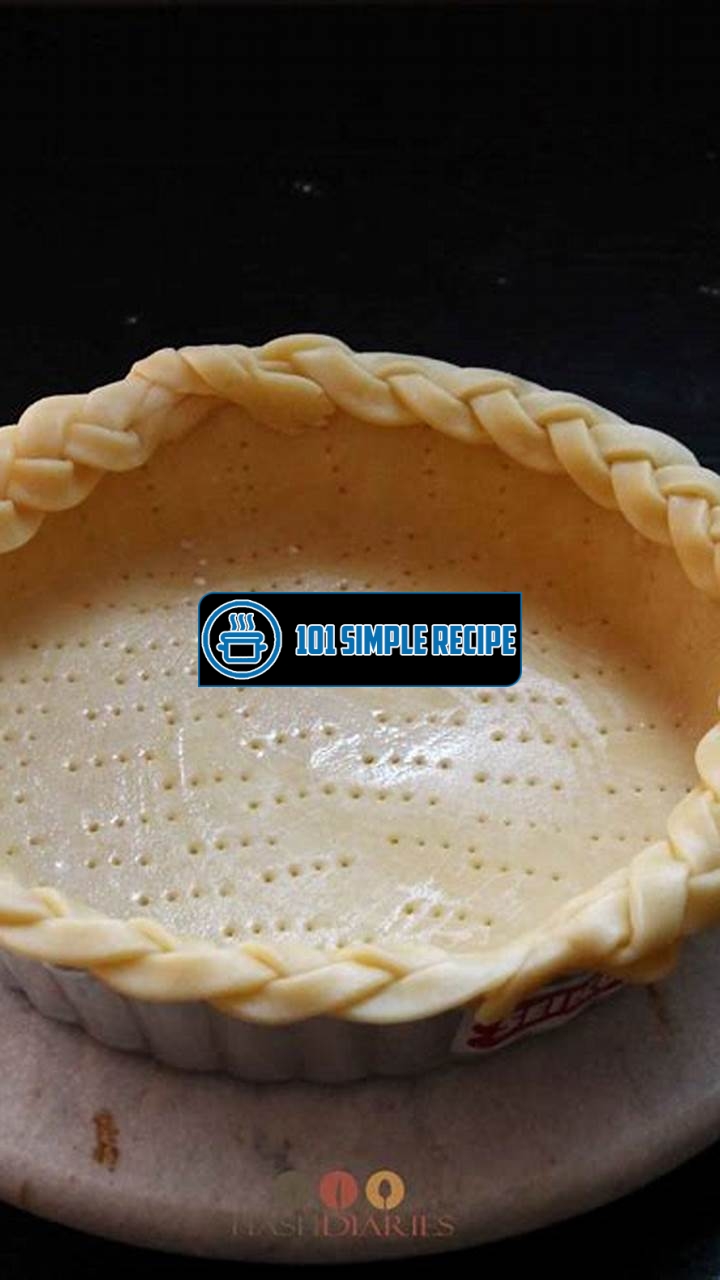Are you ready to take your pie baking to the next level? Whether you’re a seasoned baker or just starting out, mastering the art of making the best sweet pie crust is essential. A perfectly flaky, buttery crust is the foundation of any delicious pie, and with the right techniques and tips, you can achieve pastry perfection every time. In this article, we will guide you through the secrets of creating a heavenly sweet pie crust that will have your friends and family begging for seconds. So roll up your sleeves, grab your rolling pin, and let’s get started on this delectable journey together!

The Significance of a Perfect Sweet Pie Crust in New Zealand
If you’re a baking enthusiast in New Zealand, mastering the art of making a perfect sweet pie crust is a game-changer. Not only will it elevate your baking game, but it will also become a staple in your kitchen. A well-executed sweet pie crust has the power to transform a simple filling into a delectable dessert that will leave your guests craving for more.
The art of pastry making is no easy feat, but with the right techniques and a little practice, you can achieve a flawless sweet pie crust every time. Whether you’re a novice baker or an experienced pro, the key lies in understanding the fundamental techniques that make pastry-making a true art form.
The Art of Pastry Making
To create the perfect sweet pie crust, it is crucial to master the art of pastry making. This involves understanding the correct proportions of ingredients, handling the dough with precision, and knowing the optimal techniques for achieving a flaky and tender crust.
One essential technique is the “rubbing-in” method, where cold butter is cut into the flour using your fingertips or a pastry cutter. This process creates small pockets of butter within the dough, which melt during baking, resulting in a flaky texture. Another technique is “blind baking,” which involves pre-baking the crust before adding the filling, ensuring a crisp crust even with moist fillings.
Pro Tip: Remember to keep all your ingredients, including the butter and water, cold throughout the process. This helps maintain the desired texture and prevent the butter from melting too quickly.
Choosing the Right Ingredients
When it comes to creating the best sweet pie crust, choosing the right ingredients is essential. In the New Zealand culinary tradition, certain ingredients are considered staples for achieving a flavorful and tender crust.
- Flour: Opt for a high-quality all-purpose flour, preferably one with a higher protein content. This helps develop the gluten, providing structure to the crust.
- Butter: Choose unsalted butter, as it allows you to control the amount of salt in the recipe. The butter should be cold, straight from the refrigerator, to achieve those desirable flaky layers.
- Water: Ice-cold water is crucial for binding the dough, as it slows down gluten formation. Add it gradually, just enough for the dough to come together, and avoid overmixing.
- Sugar and Salt: Depending on the type of pie you’re making, add a touch of sugar or salt to enhance the flavors.
Pro Tip: For an extra flavor boost, consider adding a teaspoon of vanilla extract or a tablespoon of citrus zest to your sweet pie crust dough. These little additions can take your crust from good to exceptional.
Tips for Optimal Texture
Texture is paramount in a sweet pie crust. Striving for a delicate, flaky, and irresistibly delicious result is the ultimate goal. Here are some expert tips and tricks to ensure your sweet pie crust has that sought-after texture:
- Chill the Dough: After forming the dough, refrigerate it for at least 30 minutes before rolling it out. This allows the gluten to relax and makes the dough easier to handle.
- Rolling Technique: Roll the dough out on a lightly floured surface using a rolling pin. Start from the center and work your way out in all directions to achieve an even thickness.
- Pricking and Docking: Before blind baking the crust, prick the bottom with a fork to prevent air bubbles from forming. Additionally, using a fork or a specialized tool called a docker, make small indentations all over the dough to prevent it from puffing up too much during baking.
- Egg Wash: For a golden and glossy crust, brush the pie dough with an egg wash before baking. This gives the crust an attractive sheen and adds a hint of richness.
Pro Tip: Remember that practice makes perfect. Don’t be discouraged if your first attempt doesn’t turn out exactly as planned. With each pie crust you make, you’ll refine your skills and develop an intuitive understanding of the art of sweet pie crust making.
In conclusion, mastering the art of making the best sweet pie crust in New Zealand is a journey worth embarking on for any baking enthusiast. With attention to detail, the right techniques, and carefully selected ingredients, you can create a crust that will impress even the most discerning taste buds. So, roll up your sleeves, gather your ingredients, and let the baking adventure begin!
For a savory treat, try making our ranch oyster crackers as a delicious snack or party appetizer.
Selecting the Perfect Sweet Filling for Your Pie Crust
When it comes to making a sweet pie crust, the filling plays a crucial role in determining the flavor and overall deliciousness of the dessert. To take your pie to the next level, you need to select the perfect sweet filling that complements your homemade crust flawlessly. In this article, we will explore a range of mouthwatering sweet fillings that will delight your taste buds and impress your guests.
Classic Fruit Fillings
One of the most popular options for filling a sweet pie crust is using classic fruit fillings. In New Zealand, you have an abundance of delicious fruits to choose from, including apples, berries, and stone fruits. These fruits provide a natural sweetness and pair perfectly with a buttery and flaky crust, creating a harmonious blend of flavors. Whether you opt for a classic apple pie or a summer berry pie, these fruit fillings will surely satisfy your cravings.
Decadent Cream Fillings
If you’re looking to add a touch of luxury to your sweet pie crust, indulging in decadent cream fillings is the way to go. Options like custard, chocolate ganache, or lemon curd will elevate your dessert to new heights. The creamy texture, combined with the crispness of the crust, creates a delightful contrast that melts in your mouth. These fillings are perfect for special occasions or when you want to treat yourself to a truly indulgent dessert.
Inventive Flavor Combinations
For those who enjoy experimenting with flavors, incorporating inventive flavor combinations into your sweet pie crust filling is a must-try. Go beyond the traditional and surprise your guests with unexpected twists like spices, nuts, or even floral essences. Imagine a cardamom-infused pear pie or a pistachio and rosewater tart. These unique flavor combinations will leave a lasting impression and make your sweet pie crust stand out from the crowd. It’s all about creating a memorable and delicious experience.
So, the next time you bake a sweet pie crust, remember to consider the filling carefully. Whether you opt for classic fruit fillings, decadent cream fillings, or inventive flavor combinations, your pie will surely be a hit. Have fun experimenting, and let your creativity shine through the delicious flavors that you choose!
If you’re in the mood for a sweet and tangy treat, our pink punch recipe is the perfect choice. It’s refreshing and full of flavor.
Exploring Flavorful Crust Variations and Enhancements
Discover delightful alternatives and enhancements to traditional sweet pie crust recipes, allowing you to elevate the flavor and presentation of your pie creation.
Buttery Shortbread Crust
Indulge in the rich and buttery goodness of a shortbread crust that complements sweet fillings, adding a melt-in-your-mouth experience that will leave you craving for more.
A buttery shortbread crust is a delicious twist on the classic sweet pie crust. It offers a delicate and crumbly texture that pairs perfectly with sweet fillings like fruit or custard. The secret to achieving a perfect shortbread crust lies in the balance of butter, flour, and sugar.
To make a buttery shortbread crust, start by combining softened butter, flour, powdered sugar, and a pinch of salt in a mixing bowl. Use your hands or a pastry cutter to blend the ingredients until they resemble coarse crumbs. Then, press the mixture into the bottom and sides of a pie dish, making sure to create an even layer.
Bake the crust in a preheated oven until it turns golden brown. This will give it a slightly caramelized flavor and a beautiful crumbly texture. Once cooled, fill the crust with your favorite sweet pie filling and enjoy the indulgent combination of flavors and textures.
Almond or Hazelnut Crust
Add a delightful nutty flavor to your sweet pie crust with almond or hazelnut variations, enhancing the depth of taste and providing a delightful crunch in each bite.
For those looking to add a touch of nuttiness to their sweet pie crust, almond or hazelnut crusts are the perfect choice. These variations not only enhance the flavor but also add a satisfying crunch to each bite.
To create an almond or hazelnut crust, replace a portion of the flour in your favorite sweet pie crust recipe with ground almonds or hazelnuts. The finely ground nuts will impart a subtle nutty taste and a slightly different texture to your crust.
First, toast the nuts in a dry pan over medium heat until fragrant. Allow them to cool, then grind them in a food processor until finely ground. Mix the ground nuts with the flour, sugar, and butter until the ingredients come together to form a dough.
Press the dough into a pie dish and bake it until golden brown. The nutty aroma will fill your kitchen, and the resulting crust will provide a delicious complement to any sweet filling.
Unique Decorative Crust Designs
Learn how to create stunning and intricate decorative designs on your sweet pie crust, turning it into a visually appealing masterpiece that will impress your friends and family.
One way to take your sweet pie crust to the next level is by adding unique decorative designs. These beautiful patterns not only enhance the visual appeal of your pie but also make it a conversation starter at any gathering.
Creating decorative crust designs may seem challenging, but with a little practice and patience, anyone can master the art. Start by rolling out your pie crust dough and placing it over your filled pie. Then, use various techniques to create intricate patterns.
One popular method is to create a lattice design by weaving strips of dough over the pie filling. This creates a beautiful crisscross pattern that looks impressive and allows the filling to peek through. Another option is to use small cookie cutters to cut out shapes from the dough and arrange them in a decorative pattern.
You can also experiment with braided edges, unique cut-out shapes, or even freehand designs. Let your creativity run wild and have fun expressing yourself through your pie crust. With a little practice, you’ll be able to create stunning and Instagram-worthy designs that will wow your friends and family.
In conclusion, exploring flavorful crust variations and enhancements is a great way to elevate your sweet pie creations. Whether you opt for a buttery shortbread crust, an almond or hazelnut variation, or a unique decorative design, these additions will undoubtedly impress your taste buds and visually please your loved ones. So go ahead and get creative with your next sweet pie crust adventure!
Perfecting the Baking Process for Sweet Pie Crust Success
When it comes to creating the best sweet pie crust, following the right baking process is crucial. With a few essential steps, you can achieve a golden, flaky, and perfectly cooked delight that will wow your family and friends. Let’s dive into the key insights that will help you master the art of making the best sweet pie crust.
Preventing Soggy Bottoms
One common challenge many bakers face when making sweet pie crusts is dealing with soggy bottoms. However, by using different techniques and tricks, you can prevent this issue and achieve a perfectly crisp and delicious base for your sweet pie.
First, it’s important to properly preheat your oven. Preheating allows the crust to cook quickly and evenly, reducing the chance of moisture seeping into the bottom. Preheating your oven to the recommended temperature, usually between 400-425°F (200-220°C), will ensure a crispy result.
Another technique to prevent soggy bottoms is by using a thin layer of barrier. Apply an egg white wash or brush a layer of melted butter onto the pie crust before adding the filling. This helps create a protective barrier between the crust and the filling, preventing excess moisture from making the crust soggy.
Additionally, consider blind baking the crust before adding the filling. This involves partially or fully baking the crust without the filling. Blind baking sets the crust and seals it, preventing moisture from penetrating. Furthermore, you can dust the crust with a light coating of flour or ground nuts, such as almonds, to absorb any excess moisture and maintain a crisp texture.
Blind Baking Techniques
Blind baking is a crucial method to ensure even cooking and a flawless texture for your pie creations. There are a couple of methods you can use to blind bake your sweet pie crust.
The first method is using pie weights or dry beans. After rolling out the dough and fitting it into the pie dish, line the crust with parchment paper and fill it with pie weights or dry beans to weigh it down. This prevents the crust from puffing up and losing its shape during the baking process. Bake the crust for a few minutes, remove the weights, and continue baking until golden brown and fully cooked.
Another option is to freeze the crust before blind baking. After fitting the crust into the pie dish, pop it in the freezer for about 15-30 minutes. Freezing helps solidify the butter or fat in the pastry, preventing it from melting too quickly during baking and resulting in a soggy crust. Once the crust is firm, proceed with blind baking as usual.
Troubleshooting Common Issues
Even the most experienced bakers may encounter common issues when making sweet pie crusts. Here are some troubleshooting tips to overcome these challenges:
- Shrinking crusts: If your pie crust shrinks during baking, it’s usually a sign of insufficient chilling time. After fitting the crust into the pie dish, refrigerate it for at least 30 minutes before baking. This helps relax the gluten in the dough and prevents shrinkage.
- Overbrowning: To avoid overbrowning, cover the edges of the crust with aluminum foil or a pie crust shield. This will protect the delicate edges from excessive heat, allowing the rest of the crust to bake to perfection.
- Uneven cooking: If your pie crust cooks unevenly, try rotating the pie dish halfway through the baking process. This ensures that the heat is distributed evenly, resulting in a uniformly cooked crust.
By implementing these troubleshooting tips, you can overcome common issues and create sweet pie crusts that are both visually appealing and delectable.
Now armed with these valuable insights, you are well on your way to mastering the art of making the best sweet pie crust. Enjoy the process, experiment with different techniques, and soon enough, you’ll be able to create sweet pie crusts that impress with their golden, flaky perfection.
Serving, Storing, and Freezing Sweet Pie Crust Confections
Learn how to properly serve, store, and freeze your sweet pie crust creations, maximizing freshness and ensuring that the mouthwatering flavors remain intact.
Display and Presentation
Discover creative ways to display and present your sweet pie crust confections, elevating the overall visual appeal and making a lasting impression on your guests.
When it comes to displaying your sweet pie crust confections, the key is to make them look as tempting as they taste. One way to do this is by choosing a beautiful serving platter or cake stand that complements the colors and flavors of your pie crust. Arrange your confections in an appealing manner, considering the balance of colors and textures.
Another idea is to add decorative touches that enhance the presentation. Consider garnishing the pie crust with fresh fruits, edible flowers, or a sprinkle of powdered sugar. These simple additions can elevate the visual appeal of your creations and make them even more enticing.
Remember that presentation goes beyond just the pie crust itself. Pay attention to the plates, silverware, and napkins you use. Opt for high-quality utensils and attractive tableware that enhance the overall dining experience for your guests.
By putting effort into the display and presentation of your sweet pie crust confections, you create a memorable and visually appealing experience that will leave a lasting impression on your guests.
Longevity and Storage Tips
Ensure the longevity of your sweet pie crust treats by following proper storage guidelines, allowing you to enjoy their deliciousness for days to come.
After baking your sweet pie crust, it’s essential to let it cool completely before storing it. If you wrap it while it’s still warm, condensation can form and make the crust soggy.
To store your sweet pie crust confections, place them in an airtight container or wrap them tightly in plastic wrap. This will help prevent air exposure, keeping the crust fresh and preventing it from drying out.
For optimal freshness, store the pie crust in a cool, dry place. Avoid exposing it to direct sunlight or extreme temperatures, as this can affect the texture and flavor.
If you have leftover pie crust, consider freezing it to extend its shelf life.
Freezing Techniques
Master the art of freezing your sweet pie crust creations, enabling you to have a ready-to-enjoy treat on hand whenever the craving strikes or unexpected guests arrive.
Freezing your sweet pie crust confections is a simple process that can save you time and ensure you always have a delicious treat available. Here are some freezing techniques to follow:
- Prepare your sweet pie crust confections as usual, allowing them to cool completely before freezing.
- Wrap each individual confection tightly in plastic wrap to prevent freezer burn and maintain freshness.
- Place the wrapped confections in a freezer-safe container or freezer bag and seal it tightly.
- Label the container or bag with the date to keep track of its freshness.
- Store the pie crust confections in the freezer for up to three months.
When you’re ready to enjoy your frozen sweet pie crust, simply remove it from the freezer and let it thaw in the refrigerator overnight. Alternatively, you can reheat it in the oven at a low temperature until it reaches your desired warmth.
By mastering the art of freezing your sweet pie crust creations, you can have a delicious treat available at any time, whether it’s for a special occasion or a spontaneous dessert for unexpected guests.
Now that you’ve learned how to properly serve, store, and freeze sweet pie crust confections, you can confidently create and enjoy these mouthwatering treats without worrying about freshness or longevity. With creative presentation and proper storage techniques, your sweet pie crust creations will always impress and satisfy.
If you’re looking for more delicious dessert recipes, check out our punch bowl recipe for a refreshing and flavorful drink option.
Frequently Asked Questions
If you have any questions about our delicious sweet pie crust recipe, we’ve got you covered! Take a look at these FAQs to find the answers you need.
| No. | Questions | Answers |
|---|---|---|
| 1. | Can I use a different type of flour for the crust? | Absolutely! While our recipe calls for all-purpose flour, you can experiment with different types of flour like whole wheat or almond flour to suit your taste and dietary preferences. |
| 2. | Can I make the crust ahead of time? | Yes, you can prepare the sweet pie crust in advance. Simply wrap it tightly in plastic wrap or place it in an airtight container and refrigerate for up to 3 days. Make sure to let it come to room temperature before rolling it out for baking. |
| 3. | Can I freeze the crust? | Absolutely! The sweet pie crust can be frozen for up to 3 months. Just make sure to wrap it tightly in plastic wrap and place it in a freezer bag or container. When you’re ready to use it, thaw it in the refrigerator overnight. |
| 4. | Can I use this crust recipe for savory pies? | Yes, you can definitely use this sweet pie crust recipe for savory pies as well. Simply omit any sugar or sweeteners called for in the recipe and adjust the seasoning to suit the filling of your savory pie. |
| 5. | Can I make mini pies with this crust? | Absolutely! This sweet pie crust recipe works perfectly for making mini pies. Just use a smaller pie tin or a muffin tin and adjust the baking time accordingly. |
| 6. | Can I use this recipe for a vegan pie crust? | Yes, you can easily adapt this sweet pie crust recipe to be vegan. Simply substitute the butter with vegan margarine or coconut oil and use a plant-based milk instead of dairy milk. |
Thank You for Reading!
We hope you enjoyed learning how to make a delectable sweet pie crust with our easy-to-follow recipe. Now you can create perfect crusts for your favorite sweet pies, whether it’s a classic apple pie or a rich chocolate tart. Remember, practice makes perfect, so don’t hesitate to try different variations and get creative with your fillings. We’ll be back with more delicious recipes soon, so be sure to visit us again later. Happy baking!
Jump to Recipe
Sweet Pie Crust Recipe NZ

Learn how to make a perfect sweet pie crust with this easy-to-follow recipe. With a buttery and flaky texture, this crust is the ideal base for your favorite sweet pies. Try it with a classic apple pie or a rich chocolate tart!
- 1 1/4 cups all-purpose flour
- 1/4 cup granulated sugar
- 1/2 teaspoon salt
- 1/2 cup unsalted butter (cold and cubed)
- 3-4 tablespoons ice water
- In a large bowl, whisk together the flour, sugar, and salt.
- Add the cold cubed butter to the flour mixture. Use a pastry cutter or your hands to cut the butter into the flour until the mixture resembles coarse crumbs.
- Gradually add the ice water, one tablespoon at a time, and mix until the dough comes together. Be careful not to overmix.
- Shape the dough into a disk, wrap it in plastic wrap, and refrigerate for at least 1 hour.
- When ready to use, let the dough come to room temperature for a few minutes. Roll out the dough on a floured surface to fit your pie dish.
- Carefully transfer the rolled out dough to the pie dish. Press it gently against the bottom and sides of the dish. Trim any excess dough and crimp the edges.
- If pre-baking is needed, preheat the oven to 375°F (190°C). Line the pie crust with parchment paper or aluminum foil and fill it with pie weights or dried beans. Bake for about 12-15 minutes, or until the edges are lightly golden. Remove the weights and continue baking for another 8-10 minutes, or until the crust is fully cooked and golden brown.
- Once baked, let the crust cool completely before filling it with your favorite sweet pie filling.






